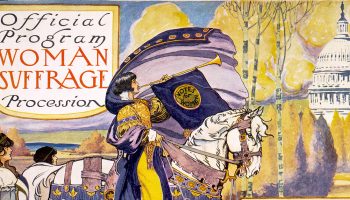This is Part 8 of The Public Medievalist’s special series: Gender, Sexism, and the Middle Ages, by Paul B. Sturtevant. You can find the rest of the series here.
Once upon a time, there was a handsome prince. Many years before, that prince was born a beautiful princess, but that doesn’t really matter. What matters is what the prince did next…
Fairy tales get a lot of flak when it comes to their treatment of gender. And rightly so. Disney made a mint off their retrograde image of the “princess” (so much so that “Disney Princess” is both a commonplace phrase and a brand). Recently, they have added princesses of color, princesses who fight, and princesses whose stories don’t revolve around a romantic relationship with a man. But despite these additions, the phrase “Disney Princess” still evokes a retrograde image of femininity: one that privileges whiteness, passivity, beauty and heteronormativity above all else.

But not all fairy tales are Disney tales.
You might be familiar with the grimmer, darker originals behind the Disney films: the ones written down by the Brothers Grimm or Hans Christian Andersen. Or, if you are really into fairy tales, you may be familiar with the stories collected by Charles Perrault, who was the first to pen versions of “Little Red Riding Hood,” “Cinderella,” “Puss in Boots,” and “Sleeping Beauty.” But despite (or perhaps because of) the grimdark perspective of many of these tales, the sexism and gender normativity remain. The key difference is that here, they are often enforced with extreme violence.
Anderson, Perrault, and the Grimm Brothers were mostly translators and adaptors; they drew from and collected a vast collection of folklore and tales passed down through oral traditions. But two of the most prolific of folklore collectors were a team you’ve probably never heard of: Leonora Blanche Alleyne and Andrew Lang. One of the stories they found and retold features a transgender medieval hero.

Thanks for Typing All of Andrew Lang’s Fairy Tales
To call Andrew Lang prolific is a bit of an understatement. Over the course of his career, in addition to numerous academic books and articles on history, mythology, folklore, and anthropology, he also published twenty-five collections of stories.
Most of these were in his “Fairy Book” series, with each book being assigned a color. The first, The Blue Fairy Book,was a surprise best seller in 1889. He then followed it up with The Red Fairy Book in 1890, The Green Fairy Book in 1892, and so on through a whole spectrum. These books collected and adapted stories from a wide range of folk traditions: French, Danish, Romanian, Spanish, Chinese, Arabian, Tunisian, Indian, American Indian, and more.
But Lang was able to be this prolific because much of the work was done by his wife, Leonora Blanche Allenye. She is credited as translator and adaptor of the tales in the prefaces to each of these books. She even assumed editorial control of the series in the 1890s. But his name is on the spines. It’s a classic case of “thanks for typing”—where male academics acknowledge but ultimately take credit for the work done by women in their lives.
So, in the interest of fairness, it is probably better to call these Alleyne’s stories rather than Lang’s.

“The Girl Who Pretended to be a Boy”
One of the stories Alleyne translated and adapted for The Violet Fairy Book in 1901 was a Romanian folktale that Alleyne called “The Girl Who Pretended to Be a Boy.” This was an English-language version of a story Alleyne found in a French collection called Sept Contes Roumains(Seven Romanian Tales), translated by Jules Brun in 1894. The name Alleyne gave the story implies an antiquated transphobic worldview, where gender-expansive people are seen as “impersonating” or “pretending.” But the story redeems itself by being remarkably trans-affirming, which is better reflected in the less pejorative title it was given by its French translator: Jouvencelle-Jouvencau, or simply, “Young Woman-Young Man”—a title perhaps not too far off from Victor/Victoria.
The original translations are in the public domain, so you can read the tale in its entirety here (or here, if you read French). But to summarize, “The Girl Who Pretended to be a Boy” has many of the ingredients of a typical medievalesque folk tale. It starts with an evil emperor who demands that newly conquered kingdoms offer up one prince for ten years of service. But one day, he conquers a kingdom whose ruler has three daughters.
The first two princesses try to pass themselves off as men, but their father (who is actually a powerful magician) tests their disguises and finds them out. But the third daughter—named Fet-Fruners—takes her father’s talking war horse and succeeds at passing as a man. She succeeds because the horse advises her on how to act as a man would, particularly by coaching her towards bravery in battle.
Thanks to her helpful, unusually talkative steed, Fet-Fruners becomes an extraordinary warrior. She successfully challenges her father (who transformed into a wolf, then a lion, and then a twelve headed dragon, because fairy tales), and a genie in single combat.
When Fet-Fruners finds herself among another genie and its mother, the horse further coaches her on how to pass—which she succeeds at doing, even though the genie’s mother tries to out her three times. She reaches the evil emperor’s court, and is sent on a quest to find a legendary woman, Iliane. Iliane had been captured by genies. Thankfully, the horse knows exactly how to get her back.
It’s becoming clear that the horse really is the hero of the story, by the way.
So, Fet-Fruners rescues Iliane from the genie, and is pursued by the genie’s fire-breathing mother (because, as in Beowulf, the monster’s mother is often even worse). But, as ever, the horse knows exactly what to do, and together they escape. They return to the Emperor’s court, where Fet-Fruners is sent on another quest. And another.
On Fet-Fruner’s final quest, she is galloping away from a church, having stolen a vase of holy water. One of the guardians of the church, a hermit, curses her:
he fell on his knees and called his most deadly curse down on her head, praying that if the thief was a man, he might become a woman; and if she was a woman, that she might become a man. In either case he thought that the punishment would be severe.
Up until this point, the story hasn’t been especially trans-affirming. Fet-Fruners is always referred to with female pronouns, or is referred to as “the Princess.” Fet-Fruners’ actions are always couched in terms of being disguised, or heroically tricking others. But the next paragraph takes a remarkable turn. It reads:
But punishments are things about which people do not always agree, and when the princess suddenly felt she was really the man she had pretended to be, she was delighted, and if the hermit had only been within reach she would have thanked him from her heart.
This is a wonderful turn. The curse was meant to give a person, in effect, gender dysphoria—by making their biological sex no longer match the gender that they were. But Fet-Fruners is euphoric at the change, implying that she was really a he all along.
Remember, (as if you could forget) this is a fairy tale. If the storyteller saw Fet-Fruner’s new sex to be a problem, there would have been another quest where her heroic horse would tell her exactly how to have the curse reversed.
But it isn’t a problem. The narrator switches pronouns. Fet-Fruner’s gender is confirmed by the court. Fet-Fruner’s horse magically kills the evil emperor. And Fet-Fruner and Iliane are married and live happily ever after.
Happy and Unhappy Endings
In some ways, “The Girl Who Pretended to Be a Boy” is ahead of its time. But in others, it is not quite as ahead of its time as we might hope it to be. This should be obvious enough from the title alone, which implies that Fet-Fruners was “pretending” right up until the point of his biological transformation, rather than expressing that his masculinity was an inherent part of who he was. But the transformation that affirms his gender, and the fact that it is regarded as a blessing to be celebrated rather than a curse to be broken, puts it head and shoulders above other fairy tales and the tradition of medieval adventure stories (aka medieval romances) from which tales like this are obviously drawn. Its affirming nature makes it subversive.
Perhaps the most comparable story in the medieval canon is the 13th century French tale Silence. Silence deserves its own article in this series, but it is useful to compare their endings.
In short, Silence is born biologically female, but is disguised by her parents so she’ll inherit their land since the king has outlawed female inheritance. He lives for many years as a boy, and so comes to think of himself as male. He learns to be a knight, and goes on several adventures. When he is twelve years old, he is then presented with a choice in a conversation between a personified Nature and Reason. Reason convinces him that if he were to choose to be a woman, he would have to give up being a knight and an heir. He also decides to remain a man because, as he puts it:
I have a mouth too hard for kisses
and arms too rough for embraces;
One could easily make a fool of me
In any game played under the covers.
In other words, in order to be a knight and have wealth, he had to be a man. Being a woman means a life of knitting and weaving.
It’s sexist as hell.
Anyway, Silence has a variety of other heroic adventures, where he excels both as a knight and as a minstrel. But at the very end of the story, Merlin outs Silence in front of the whole royal court. King Evan then strips Silence of his male clothing, renames him “Silentia,” and makes him his new queen.
The author may have expected this story to be read like other romances—that the ending entails the King putting everything that was wrong back to rights. But if the reader accepts that Silence is transgender, the story is a crushing tragedy: he is outed, deadnamed, misgendered, and forced to marry. Shoved back into the closet, the reader is left to assume that Silence is forced to give up his life of adventure, and loses the heroic agency he enjoyed so much. Happily ever after, this is not.
In both “The Girl Who Pretended to Be a Boy” and Silence, the only way for a woman to go on heroic adventures is to be a man; qualities like bravery and prowess are ascribed exclusively to men in both. But they also both subvert gender norms, because they both show that people born biologically female are just as capable of martial heroism as people born male.
And in “The Girl Who Pretended to Be a Boy,” a happy ending means giving Fet-Fruners a male body. The ending implies that Fet-Fruners had always been a man deep down.
We must give credit to Ms. Alleyne for that. Because while the sex change occurs in the French version of “The Girl Who Pretended to Be A Boy” from which she adapted it, the crucial part where the story reads
But punishments are things about which people do not always agree, and when the princess suddenly felt she was really the man she had pretended to be, she was delighted, and if the hermit had only been within reach she would have thanked him from her heart.
seems to be a new addition by Alleyne. It is easy to see how a gender non-conforming child in 1901 reading The Violet Fairy Book might find it inspiring.
In fact, to move the story into the 21st century (and to illustrate how easy it is to make this story more gender affirming), I have edited my own version of the tale you can find here. The original is in the public domain; feel free to share it with whoever would enjoy it.
Fairy tales are important. Even though they may seem frivolous, they reflect human hopes, dreams, and fears. And more, they mirror human emotions: as you can see, transgender identity has always been a part of life, even in these old stories. And better yet, these fairy tales teach children that truth, and offer trans, genderqueer and non-binary readers heroes and heroines in their own image.
Because as even Disney is coming to realize, your ability to be a hero has nothing to do with the body you were born with, and everything to do with who you decide to be.
If you enjoyed that article, please share it with your history-loving friends on Facebook, or on Twitter! And be sure to subscribe here to receive every new article from The Public Medievalist the moment it launches.




